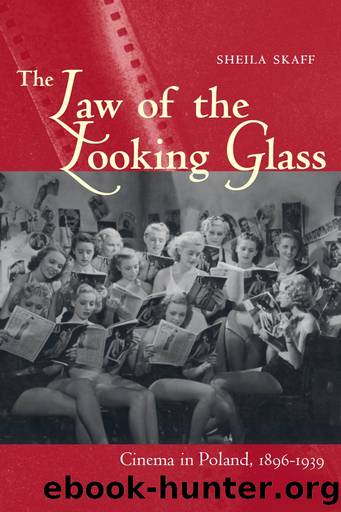The Law of the Looking Glass by Sheila Skaff

Author:Sheila Skaff [Skaff, Sheila]
Language: eng
Format: epub
Tags: Performing Arts, Film, History & Criticism
ISBN: 9780821417843
Google: dO7fuEHARnIC
Publisher: Ohio University Press
Published: 2008-01-15T03:56:02+00:00
6
The Transition in Practice, 1930â36
Flaming Hearts: Historical Sound Films
WAS THERE A âPOLISH NATIONAL CINEMAâ before World War II? It is difficult to answer this question in a way that adequately reflects the conditions under which the fledgling film industry created and exhibited films before World War II. First, the film industry in Poland was never an entity completely separate from the film industries of western Europe and the United States. From French itinerant exhibitor Eugène Joachim DuPont to Yiddish film producer Joseph Green (Józef Grinberg), international representatives ensured that cinema was not a strictly national endeavor. Second, people came from every ethnic group to work in an industry that allowed for much more professional integration than other businesses. Those who made Yiddish-language films also made Polish-language films, and vice versa. Directors moved among several production companies. Many screenwriters spoke multiple languages; they and composers freelanced on projects for various producers. Critics wrote for several publications at a time. These were not isolated instances of interethnic cooperation: they were the norm. As important as it is to understand how separate national identities developed through cinema, it is even more important to recognize that they did not develop in isolation from each other.
The linguistic and ethnic conflicts that plagued exhibition were both practical and abstract, and they defied solution. According to film scholar Alina Madej, exhibitors perceived Polish-Catholic patriotic films as attractiveâa magnetâto audiences: âAfter Poland gained independence, it seemed as though this magnet would become a broadly conceived notion of Polishness. In the interwar years, there began to take shape a model of a film spectator that was to serve to disarm the more or less imaginary Polish inferiority complexes. Film producers assumed that in this way, they would satisfy social expectations and fulfill their patriotic mission at the same time.â The film industry âwanted to avoid dissonance both with the popular vision of cultural history that was disseminated in the lower regions and with its official version that various, permanent social-cultural institutions guarded, at any cost. Cautious of conflict with the government, which was represented in the film industry by censors, producers supported the patriotic education formulated by the ideologues of the governing camp with all their might.â Still, she adds, âThe patriotic declarations in magazines and film programs were too often announced in vain, which was the result of poor recognition of audiencesâ real tastes.â1
Madej claims that patriotic declarations were not helpful in the countryside, either, but for a different reason. The reintroduction of traveling cinema in the late 1930s âwas supposed to promulgate film culture in the remote parts of Poland that had not known the invention since the days of the Lumière brothers. The rural population looked upon its organizers with distrust. They considered âfilm peopleâ everyday swindlers and con men, an assumption that could have influenced the Catholic clergyâs aversion to cinema. However, laterâas was written on the pages of Film in 1939ââThey had a hard time watching the films. They cried and laughed, and in
Download
This site does not store any files on its server. We only index and link to content provided by other sites. Please contact the content providers to delete copyright contents if any and email us, we'll remove relevant links or contents immediately.
Still Foolin’ ’Em by Billy Crystal(36301)
Spell It Out by David Crystal(36082)
The Great Music City by Andrea Baker(31755)
Professional Troublemaker by Luvvie Ajayi Jones(29619)
Trainspotting by Irvine Welsh(21564)
Call Me by Your Name by André Aciman(20427)
We're Going to Need More Wine by Gabrielle Union(19001)
The Secret History by Donna Tartt(18939)
Cat's cradle by Kurt Vonnegut(15251)
Ready Player One by Cline Ernest(14573)
Molly's Game by Molly Bloom(14101)
Bombshells: Glamour Girls of a Lifetime by Sullivan Steve(14019)
The Goal (Off-Campus #4) by Elle Kennedy(13599)
Leonardo da Vinci by Walter Isaacson(13232)
4 3 2 1: A Novel by Paul Auster(12328)
The Social Justice Warrior Handbook by Lisa De Pasquale(12163)
The Break by Marian Keyes(9334)
Crazy Rich Asians by Kevin Kwan(9216)
The remains of the day by Kazuo Ishiguro(8887)
